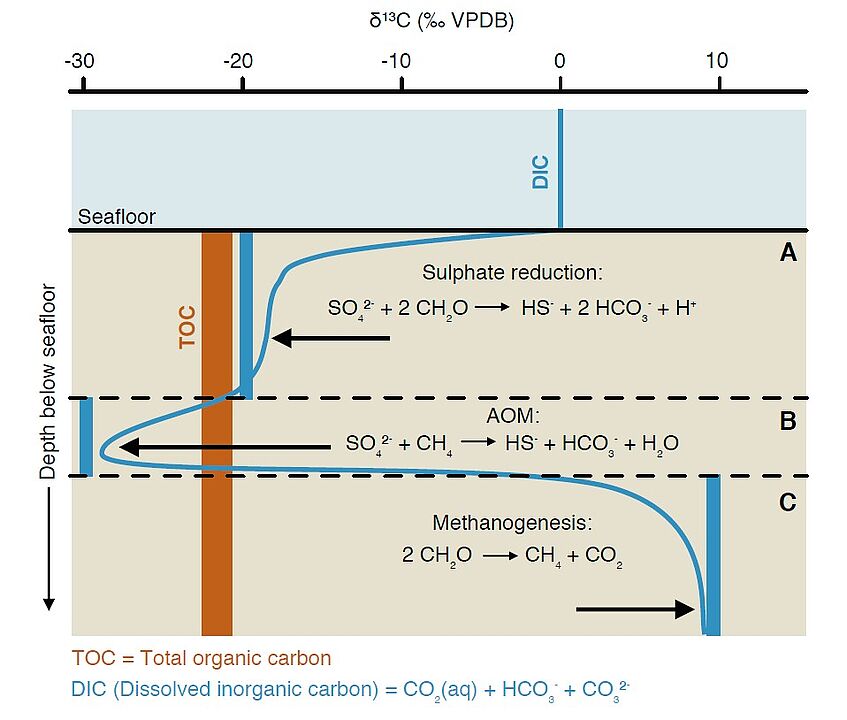Simulating biogeochemical processes with numerical models
Unconsolidated marine sediments are commonly characterized by a depth zonation in redox-active chemical species. The zonation is a result of microbial metabolisms, consuming available electron acceptors in the sequence of their redox potential. Hence, a redox zonation is the expression of active microbial life below the seafloor – the deep biosphere.
Dynamics of the deep biosphere over millions of years
Redox zonation largely depends on the content, reactivity, and burial rate of organic carbon substrates, as shown by reaction-transport modelling (Meister et al., 2013). Redox zones in marine sediments can change in response to variations of oceanographic conditions over geological time (Meister et al., 2007; Contreras et al., 2013; Meister, 2015).
Full-speciation reaction-transport modelling
In a new modelling study (Meister et al., 2022) the full chemical speciation in marine porewater was reproduced through a 230-m-thick sedimentary sequence drilled in the Peru-Chile Trench. The model shows how microbial metabolism, mineral reactions, and diffusive transport result in high alkalinity within the methanogenic zone. High alkalinity buffers the pH and supports the formation and burial of diagenetic carbonates.
The model code written in C++ links the reaction and transport of more than 90 chemical species to Phreeqc, an open-source aqueous-speciation program available from the U.S. geological survey. The model is now applicable to many sites in the world’s oceans, wherever porewater chemistry has been measured. Being able to simulate the evolution of porewater chemistry, including the state of the carbonate system, throughout a depth profile over millions of years is a requirement for correctly predicting carbonate diagenesis, transport of gas phases, alkalinity fluxes to the water column, and many other effects of marine porewater chemistry.
Measured (solid symbols) and simulated porewater concentration profiles (lines) vs. depth at Ocean Drilling Program Site 1230, drilled in the Peru-Chile Trench: (A) sulphate and methane; (B) ammonium; (C) inorganic carbon species; (D) pH (dashed line: after equilibration with headspace); (E) dissolved inorganic carbon and total alkalinity; (F) Ca and Mg; (G) K, Na, and Cl; and (H) otal Si. All concentrations are reported in mmol/L. Dotted lines: simulation including microbial reactions; solid lines: simulation including microbial and mineral reactions. Measured data are from D’Hondt et al. (2003) and Donohue et al. (2006). For details see Meister et al. (2022).
Simulating carbon isotope systematics
Reaction-transport modelling further contributed to the understanding of carbon isotope systematics in aquatic sediments and how they are influenced by different microbial metabolisms. Especially, the large fractionation through methanogenic pathways impose strong effects on carbon isotope distribution in dissolved carbon species and carbonates (e.g., Meister et al., 2007; Birgel et al., 2015; Meister et al., 2019a; Meister et al., 2019b). An overview of this work is given in the review paper “The carbon isotope record of the subseafloor biosphere” (Meister and Reyes, 2019), which received the MDPI Geosciences best-paper award.
Schematic distribution of δ13C of DIC in marine porewater: (A) sulphate reduction zone; (B) sulphate-methane transition zone; (C) methanogenic zone. The thick blue bars represent the isotopic compositions of the instantaneously produced metabolic DIC; the thin blue line represents the resulting isotope profile of DIC. Figure reproduced from Meister and Reyes (2019).
Microbial mats: a miniature “deep biosphere”
Scenarios reconstructed for past microbial processes can always be tested using geochemical models. For example, it could be demonstrated that microbial sulphate reduction has very little potential to induce carbonate precipitation in microbial mats (Meister, 2013; 2014). Instead, phototrophic reactions along with abiotic conditions have to be taken into account for calcification of microbial mats. This insight has consequences for the interpretation of stromatolites, suggested to represent lithified microbial mats as one of the earliest forms of life on Earth.
How the deep biosphere interacts with global biogeochemical cycles
Numerical models are now available that will help to solve many problems in marine biogeochemistry. In the future, models reproducing the evolution of the deep biosphere at specific sites can be extrapolated to a global scale, linking material and energy fluxes across the seafloor with global oceanographic and biogeochemical models, which can help us to understand the role of the deep biosphere in Earth’s exogenic cycle.



